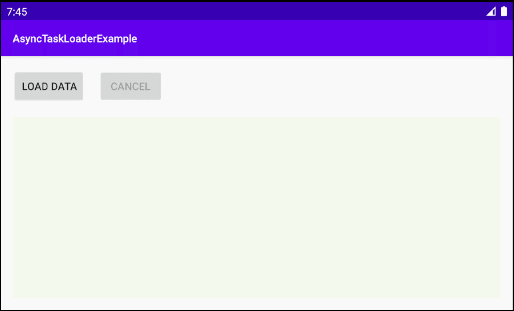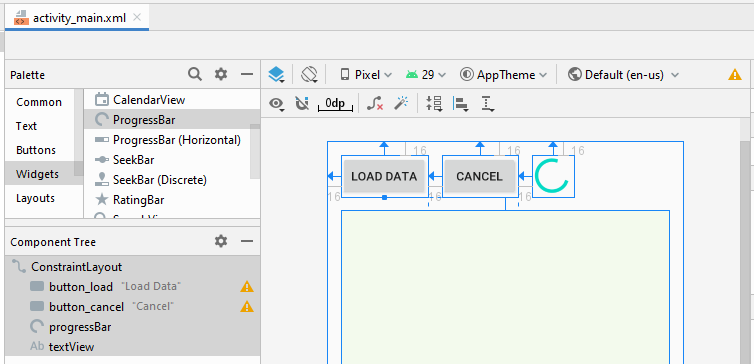Android AsyncTaskLoader Tutorial with Examples
1. Android AsyncTaskLoader
AsyncTaskLoader is used to perform an asynchronous task in the background of the application, so the user can also interact with the application during that process. As soon as the task is completed, the result will be updated to the interface.
AsyncTaskLoader performs the same functions as AsyncTask; however, AsyncTaskLoader is thought to be better, for the following reasons:
AsyncTask and AsyncTaskLoader have different behaviors when the configuration of the device changes, for example, if the user rotates the device screen, Activity can be destroyed and re-created. In that case:
- AsyncTask will be re-executed and a new Thread will be created, whereas the old Thread will become separate and uncontrolled.
- AsyncTaskLoader will be re-used based on the Loader ID that has been registered with the LoaderManager before. As a result, it prevents the duplication of background tasks, and avoids the creation of useless tasks.
Android AsyncTaskLoader Javadocs:See more:
2. Example of AsyncTaskLoader
In this example I'm going to use AsyncTaskLoader to load a list of UserAccount and display it in the interface. The data can be retrieved from a URL or from a database. This task is implemented in the background of the application, so during this process, the user still probably interacts with the application.

On Android Studio create a project:
- File > New > New Project > Empty Activity
- Name: AsyncTaskLoaderExample
- Package name: org.o7planning.asynctaskloaderexample
- Language: Java
The application interface will look like this:

main_activity.xml
<?xml version="1.0" encoding="utf-8"?>
<androidx.constraintlayout.widget.ConstraintLayout
xmlns:android="http://schemas.android.com/apk/res/android"
xmlns:app="http://schemas.android.com/apk/res-auto"
xmlns:tools="http://schemas.android.com/tools"
android:layout_width="match_parent"
android:layout_height="match_parent"
tools:context=".MainActivity">
<Button
android:id="@+id/button_load"
android:layout_width="wrap_content"
android:layout_height="wrap_content"
android:layout_marginStart="16dp"
android:layout_marginLeft="16dp"
android:layout_marginTop="16dp"
android:text="Load Data"
app:layout_constraintStart_toStartOf="parent"
app:layout_constraintTop_toTopOf="parent" />
<Button
android:id="@+id/button_cancel"
android:layout_width="wrap_content"
android:layout_height="wrap_content"
android:layout_marginStart="16dp"
android:layout_marginLeft="16dp"
android:layout_marginTop="16dp"
android:text="Cancel"
app:layout_constraintStart_toEndOf="@+id/button_load"
app:layout_constraintTop_toTopOf="parent" />
<ProgressBar
android:id="@+id/progressBar"
style="?android:attr/progressBarStyle"
android:layout_width="wrap_content"
android:layout_height="wrap_content"
android:layout_marginStart="16dp"
android:layout_marginLeft="16dp"
android:layout_marginTop="16dp"
app:layout_constraintStart_toEndOf="@+id/button_cancel"
app:layout_constraintTop_toTopOf="parent" />
<TextView
android:id="@+id/textView"
android:layout_width="0dp"
android:layout_height="0dp"
android:layout_marginStart="16dp"
android:layout_marginLeft="16dp"
android:layout_marginTop="16dp"
android:layout_marginEnd="16dp"
android:layout_marginRight="16dp"
android:layout_marginBottom="16dp"
android:background="#F3FAED"
app:layout_constraintBottom_toBottomOf="parent"
app:layout_constraintEnd_toEndOf="parent"
app:layout_constraintStart_toStartOf="parent"
app:layout_constraintTop_toBottomOf="@+id/button_load" />
</androidx.constraintlayout.widget.ConstraintLayout>UserAccountTaskLoader.java
package org.o7planning.asynctaskloaderexample;
import android.content.Context;
import android.os.SystemClock;
import androidx.loader.content.AsyncTaskLoader;
import java.util.ArrayList;
import java.util.List;
public class UserAccountTaskLoader extends AsyncTaskLoader<List<UserAccount>> {
private String param1;
private String param2;
public UserAccountTaskLoader(Context context, String param1, String param2) {
super(context);
this.param1 = param1;
this.param2 = param2;
}
@Override
public List<UserAccount> loadInBackground() {
// Do something, for example:
// - Download data from URL and parse it info Java object.
// - Query data from Database into Java object.
List<UserAccount> list = new ArrayList<UserAccount>();
list.add(new UserAccount("tom", "tom@example.com", "Tom"));
list.add(new UserAccount("jerry", "jerry@example.com", "Jerry"));
list.add(new UserAccount("donald", "donald@example.com", "Donald"));
SystemClock.sleep(2000); // 2 Seconds.
return list;
}
}MainActivity.java
package org.o7planning.asynctaskloaderexample;
import androidx.annotation.NonNull;
import androidx.annotation.Nullable;
import androidx.appcompat.app.AppCompatActivity;
import androidx.loader.app.LoaderManager;
import androidx.loader.content.Loader;
import android.os.Bundle;
import android.util.Log;
import android.view.View;
import android.widget.Button;
import android.widget.ProgressBar;
import android.widget.TextView;
import java.util.List;
public class MainActivity extends AppCompatActivity //
implements LoaderManager.LoaderCallbacks<List<UserAccount>>,
Loader.OnLoadCanceledListener<List<UserAccount>> {
private static final String LOG_TAG = "AndroidExample";
private static final int LOADER_ID_USERACCOUNT = 10000;
private Button buttonLoad;
private Button buttonCancel;
private ProgressBar progressBar;
private TextView textView;
private static final String KEY_PARAM1 = "SomeKey1";
private static final String KEY_PARAM2 = "SomeKey2";
private LoaderManager loaderManager;
@Override
protected void onCreate(Bundle savedInstanceState) {
super.onCreate(savedInstanceState);
setContentView(R.layout.activity_main);
this.buttonLoad = (Button) this.findViewById(R.id.button_load);
this.buttonCancel = (Button) this.findViewById(R.id.button_cancel);
this.progressBar = (ProgressBar) this.findViewById(R.id.progressBar);
this.textView = (TextView) this.findViewById(R.id.textView);
// Hide ProgressBar.
this.progressBar.setVisibility(View.GONE);
this.buttonCancel.setEnabled(false);
this.buttonLoad.setOnClickListener(new View.OnClickListener() {
@Override
public void onClick(View v) {
clickButtonLoad();
}
});
this.buttonCancel.setOnClickListener(new View.OnClickListener() {
@Override
public void onClick(View v) {
clickButtonCancel();
}
});
this.loaderManager = LoaderManager.getInstance(this);
}
// User click on "Load Data" button.
private void clickButtonLoad() {
this.textView.setText("");
Log.i(LOG_TAG, "loadUserAccount");
LoaderManager.LoaderCallbacks<List<UserAccount>> loaderCallbacks = this;
// Arguments:
Bundle args = new Bundle();
args.putString(KEY_PARAM1, "Some value1");
args.putString(KEY_PARAM2, "Some value2");
// You can pass a null args to a Loader
Loader<List<UserAccount>> loader = this.loaderManager.initLoader(LOADER_ID_USERACCOUNT, args, loaderCallbacks);
try {
loader.registerOnLoadCanceledListener(this); // Loader.OnLoadCanceledListener
} catch(IllegalStateException e) {
// There is already a listener registered
}
loader.forceLoad(); // Start Loading..
}
// User click on "Cancel" button.
private void clickButtonCancel() {
Log.i(LOG_TAG, "cancelLoadUserAccount");
Loader<List<UserAccount>> loader = this.loaderManager.getLoader(LOADER_ID_USERACCOUNT);
if(loader != null) {
boolean cancelled = loader.cancelLoad();
}
}
// Implements method of LoaderManager.LoaderCallbacks
@NonNull
@Override
public Loader<List<UserAccount>> onCreateLoader(int id, @Nullable Bundle args) {
Log.i(LOG_TAG, "onCreateLoader");
this.progressBar.setVisibility(View.VISIBLE); // To show
if(id == LOADER_ID_USERACCOUNT) {
this.buttonLoad.setEnabled(false);
this.buttonCancel.setEnabled(true);
// Parameters:
String param1 = (String) args.get(KEY_PARAM1);
String param2 = (String) args.get(KEY_PARAM2);
// Return a Loader.
return new UserAccountTaskLoader(MainActivity.this, param1, param2);
}
throw new RuntimeException("TODO..");
}
// Implements method of LoaderManager.LoaderCallbacks
@Override
public void onLoadFinished(@NonNull Loader<List<UserAccount>> loader, List<UserAccount> data) {
Log.i(LOG_TAG, "onLoadFinished");
if(loader.getId() == LOADER_ID_USERACCOUNT) {
// Destroy a Loader by ID.
this.loaderManager.destroyLoader(loader.getId());
StringBuilder sb = new StringBuilder();
for(UserAccount userAccount: data) {
sb.append("Username:").append(userAccount.getUserName()).append("\t") //
.append("Email:").append(userAccount.getEmail()).append("\n");
}
this.textView.setText(sb.toString());
// Hide ProgressBar.
this.progressBar.setVisibility(View.GONE);
this.buttonLoad.setEnabled(true);
this.buttonCancel.setEnabled(false);
}
}
// Implements method of LoaderManager.LoaderCallbacks
@Override
public void onLoaderReset(@NonNull Loader<List<UserAccount>> loader) {
Log.i(LOG_TAG, "onLoaderReset");
this.textView.setText("");
}
// Implements method of Loader.OnLoadCanceledListener
@Override
public void onLoadCanceled(@NonNull Loader<List<UserAccount>> loader) {
Log.i(LOG_TAG, "onLoadCanceled");
if(loader.getId() == LOADER_ID_USERACCOUNT) {
// Destroy a Loader by ID.
this.loaderManager.destroyLoader(loader.getId());
this.progressBar.setVisibility(View.GONE); // To hide
this.buttonLoad.setEnabled(true);
this.buttonCancel.setEnabled(false);
}
}
}UserAccount.java
package org.o7planning.asynctaskloaderexample;
public class UserAccount {
private String userName;
private String email;
private String fullName;
public UserAccount(String userName, String email, String fullName) {
this.userName = userName;
this.email = email;
this.fullName = fullName;
}
public String getUserName() {
return userName;
}
public void setUserName(String userName) {
this.userName = userName;
}
public String getEmail() {
return email;
}
public void setEmail(String email) {
this.email = email;
}
public String getFullName() {
return fullName;
}
public void setFullName(String fullName) {
this.fullName = fullName;
}
}Android Programming Tutorials
- Configure Android Emulator in Android Studio
- Android ToggleButton Tutorial with Examples
- Create a simple File Finder Dialog in Android
- Android TimePickerDialog Tutorial with Examples
- Android DatePickerDialog Tutorial with Examples
- What is needed to get started with Android?
- Install Android Studio on Windows
- Install Intel® HAXM for Android Studio
- Android AsyncTask Tutorial with Examples
- Android AsyncTaskLoader Tutorial with Examples
- Android Tutorial for Beginners - Basic examples
- How to know the phone number of Android Emulator and change it
- Android TextInputLayout Tutorial with Examples
- Android CardView Tutorial with Examples
- Android ViewPager2 Tutorial with Examples
- Get Phone Number in Android using TelephonyManager
- Android Phone Call Tutorial with Examples
- Android Wifi Scanning Tutorial with Examples
- Android 2D Game Tutorial for Beginners
- Android DialogFragment Tutorial with Examples
- Android CharacterPickerDialog Tutorial with Examples
- Android Tutorial for Beginners - Hello Android
- Using Android Device File Explorer
- Enable USB Debugging on Android Device
- Android UI Layouts Tutorial with Examples
- Android SMS Tutorial with Examples
- Android SQLite Database Tutorial with Examples
- Google Maps Android API Tutorial with Examples
- Android Text to Speech Tutorial with Examples
- Android Space Tutorial with Examples
- Android Toast Tutorial with Examples
- Create a custom Android Toast
- Android SnackBar Tutorial with Examples
- Android TextView Tutorial with Examples
- Android TextClock Tutorial with Examples
- Android EditText Tutorial with Examples
- Android TextWatcher Tutorial with Examples
- Format Credit Card Number with Android TextWatcher
- Android Clipboard Tutorial with Examples
- Create a simple File Chooser in Android
- Android AutoCompleteTextView and MultiAutoCompleteTextView Tutorial with Examples
- Android ImageView Tutorial with Examples
- Android ImageSwitcher Tutorial with Examples
- Android ScrollView and HorizontalScrollView Tutorial with Examples
- Android WebView Tutorial with Examples
- Android SeekBar Tutorial with Examples
- Android Dialog Tutorial with Examples
- Android AlertDialog Tutorial with Examples
- Android RatingBar Tutorial with Examples
- Android ProgressBar Tutorial with Examples
- Android Spinner Tutorial with Examples
- Android Button Tutorial with Examples
- Android Switch Tutorial with Examples
- Android ImageButton Tutorial with Examples
- Android FloatingActionButton Tutorial with Examples
- Android CheckBox Tutorial with Examples
- Android RadioGroup and RadioButton Tutorial with Examples
- Android Chip and ChipGroup Tutorial with Examples
- Using image assets and icon assets of Android Studio
- Setting SD Card for Android Emulator
- ChipGroup and Chip Entry Example
- How to add external libraries to Android Project in Android Studio?
- How to disable the permissions already granted to the Android application?
- How to remove applications from Android Emulator?
- Android LinearLayout Tutorial with Examples
- Android TableLayout Tutorial with Examples
- Android FrameLayout Tutorial with Examples
- Android QuickContactBadge Tutorial with Examples
- Android StackView Tutorial with Examples
- Android Camera Tutorial with Examples
- Android MediaPlayer Tutorial with Examples
- Android VideoView Tutorial with Examples
- Playing Sound effects in Android with SoundPool
- Android Networking Tutorial with Examples
- Android JSON Parser Tutorial with Examples
- Android SharedPreferences Tutorial with Examples
- Android Internal Storage Tutorial with Examples
- Android External Storage Tutorial with Examples
- Android Intents Tutorial with Examples
- Example of an explicit Android Intent, calling another Intent
- Example of implicit Android Intent, open a URL, send an email
- Android Services Tutorial with Examples
- Android Notifications Tutorial with Examples
- Android DatePicker Tutorial with Examples
- Android TimePicker Tutorial with Examples
- Android Chronometer Tutorial with Examples
- Android OptionMenu Tutorial with Examples
- Android ContextMenu Tutorial with Examples
- Android PopupMenu Tutorial with Examples
- Android Fragments Tutorial with Examples
- Android ListView Tutorial with Examples
- Android ListView with Checkbox using ArrayAdapter
- Android GridView Tutorial with Examples
Show More